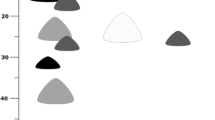Summary
Alates and primary reproductives were scarce in field colonies which were found in damp decaying logs and stumps on the forest floor. Colonies counted were found to be relatively small compared with those of higher termites and most were found to be headed by a pair or more of supplementary reproductives.
A strong correlation was found between headwidth and the number of larval plate ridges on the right mandible which indicated that inP. adamsoni the basic number of larval instars is seven. Pairs of supplementary reproductives held at constant temperatures of 15°, 20° and 25°C produced brood; brood production was inhibited at 28°C. Although 25°C was more satisfactory for the development of primary colonies, 20°C appeared to be more satisfactory for continued development of colonies.
Résumé
Les ailés et reproducteurs primaires sont peu nombreux dans les colonies trouvées sur le terrain dans les troncs et les souches décomposées sur le sol. Les colonies dénombrées apparaissent relativement petites par rapport à celles des termites supérieurs et la plupart possèdent des sexués de remplacement (une paire ou davantage).
La corrélation existant entre la largeur de la tête et le nombre des denticulations de la plaque molaire des mandibules montre qu'il existe 7 stades larvaires.
Les couples de reproducteurs supplèmentaires élevés au laboratoire à température constante de 15°, 20° ou 25°C produisent du couvain; la formation du couvain est inhibée à 28°C. Bien qu'une température de 25°C soit la plus favorable pour la fondation d'une colonie, la température de 20°C semble préférable pour un élevage de plus longue durée.
Similar content being viewed by others
References
Buchli (H.), 1958. — L'origine des castes et les potentialités ontogéniques des termites européens du genreReticulitermes.Ann. Sci. nat., Zool., 11, 263–429.
Castle (G. B.), 1934. — An experimental investigation of Caste differentiation inZootermopsis angusticollis.In: Termites and Termite Control (C. A. Kofoid ed.), 2nd éd., pp. 292–310.Univ. of California Press, édit., Berkeley, California, 734 p.
Gay (F. J.), Greaves (T.), Holdaway (F. G.) andWetherly (A. H.), 1955. — Standard laboratory colonies of termites for evaluating the resistance of timber, timber preservatives, and other materials to termite attack.Aust. Commonw. S.I.R.O. Bull., 277, 60 p.
Greaves (T.), 1959. — Termites as forest pests.Aust. For., 23, no 2, 114–120. — 1963. In Commonwealth Sci. and Ind. Res. Org. Australia Div. Ent., 1962–1963.Ann. Rep. Termites in forest trees, Canberra, 74–75.
Harris (W. V.), 1958. — Colony formation in the Isoptera.Proc. 10th Internal. Congr. Ent., Montreal, 1956,2, 435–439.
Hickin (N. E.), 1963. — The Insect factor in wood decay.Hutchinson and Co., édit., London and New York, 383 p.
Hill (G. F.), 1942. — Termites (Isoptera) from the Australian Region.Aust. Counc. Sci. Ind. Res. Melbourne, 479 p.
Light (S. F.) andWeesner (F. M.), 1947. — Methods for culturing Termites.Sciences, 106, 131.
Light (S. F.), 1934. — The constitution and development of the termite Colony. In «Termites and Termite Control» (C. A. Kofoid, édit., 2nd édit.), pp. 22–41.Univ. of California Press, édit., Berkeley, California, 734 p.
McMahan (E. A.), 1962. — Laboratory studies of colony establishment and development inCryptotermes brevis (Walker) (Isoptera Kalotermitidae).Proc. Hwwaii. Entomol. Soc., 18, 145–153.
Morgan (F. D.), 1959. — The ecology and external morphology ofStolotermes ruficeps Braue (Isoptera: Hodotermitidae).Trans. R. Soc. N. Z., 86, 155–196.
Nagin (R.), 1972. — Caste determination inNeotermes jouteli (Banks).Ins. Soc., 19, 39–61.
Noirot (C.), 1969. — Formation of castes in the higher termites. In “Biology of Termites” (K. Krishna and F. M. Weesner, édit.),1 Academic Press, édit., N. Y. and London, 598 p.
Nutting (W. L.), 1969. — Flight and colony foundation. In “Biology of Termites” (K. Krishna and F. M. Weesner, édit.),1, pp. 233–282.Academic Press, édit, N. Y. and London, 598 p.
Weesner (F. M.), 1969. — The reproductive system, in «Biology of Termites” (K. Krishna and F. M. Weesner, édit.),1, pp. 125–160.Academic Press, édit., N. Y. and London, 598 p.
Wilkinson (W.), 1962. — Dispersal of alates and establishment of new Colonies inCryptotermes havilandi (Sjöstedt) (Isoptera, Kalotermitidae).Bull. Entomol. Res., 53, 265–286.
Author information
Authors and Affiliations
Rights and permissions
About this article
Cite this article
Mensa-Bonsu, A. The biology and development ofPorotermes adamsoni (Froggatt) (Isoptera, Hodotermitidae). Ins. Soc 23, 155–165 (1976). https://doi.org/10.1007/BF02223848
Received:
Accepted:
Issue Date:
DOI: https://doi.org/10.1007/BF02223848




